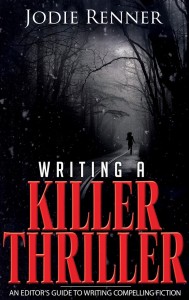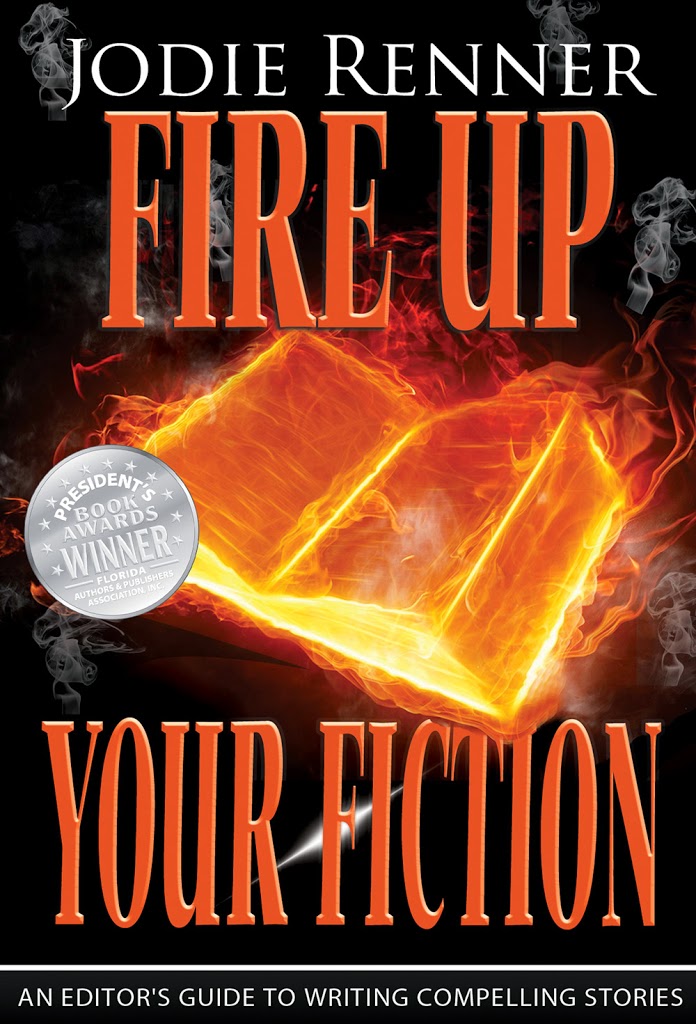I’m excited to announce that editor and award-winning author, Jodie Renner, is joining TKZ. Jodie has made numerous guest appearances here, sharing her wealth of knowledge and experience with everyone. She will be a terrific addition to our team. We look forward to seeing Jodie’s posts as she alternates with Clare on Mondays. Welcome to the Zone, Jodie. – Joe Moore
TKZ. Jodie has made numerous guest appearances here, sharing her wealth of knowledge and experience with everyone. She will be a terrific addition to our team. We look forward to seeing Jodie’s posts as she alternates with Clare on Mondays. Welcome to the Zone, Jodie. – Joe Moore
Thanks so much, Joe! I’m honored to join such a talented, articulate group of writers here on The Kill Zone! – Jodie Renner
BTW, for any of you authors interested in techniques for adding tension, suspense and intrigue to your novels, I have two articles on this topic in the latest two issues of Suspense Magazine.
* * *
State Cause Before Effect, Stimulus before Response
by Jodie Renner
Have you ever been engrossed in a novel, reading along, when you hit a blip that made you go “huh?” or “why?” for a nanosecond? Then you had to reread the sentence to figure out what’s going on?
Often, it’s because actions are written in a jumbled-up or reversed order, rather than the order they occurred. Do this too often, and your readers will start getting annoyed.
For example:
John pulled the Mercedes up and Karen got her brand-new shoes soaking wet when she quickly opened the door and stepped right into a puddle.
First the reader reads: “John pulled the Mercedes up and Karen got her brand-new shoes soaking wet” and goes “Huh?”, then reads the rest and is subliminally irritated that he had to reformulate his original thought-image.
Better: John pulled the Mercedes up and Karen quickly opened the door and stepped out — right into a puddle. Her brand new shoes were soaking wet.
In my blog post here last Wed. on bringing your characters to life by showing their reactions and emotions, I discussed showing immediate, visceral reactions before the delayed, reasoned ones. In other words, showing character reactions in the order they occur, starting with the emotional reaction and automatic reflex, which should occur immediately after the stimulus, just like it does in real life, not with a delay to explain anything.
Along the same vein, when showing actions and reactions in your fiction, it’s important to pay attention to the syntax of the sentence.
In general, state the cause before the effect, the action before the reaction, the stimulus before the response.
This way, the ideas flow more naturally and smoothly, and readers don’t have to skip back in the sentence to figure out what’s going on, which confuses them momentarily and jolts them out of the story.
As Ingermanson and Economy say in Writing Fiction for Dummies, “Here’s a critical rule: Always get the time sequence correct and always put the cause before the effect.”
Similarly, Dwight V. Swain discusses this same issue when he talks about “motivation-reaction units” in his excellent book, Techniques of the Selling Writer.
Here are some “before and after” examples, disguised, from my fiction editing. The “after” examples are just one or two of many possibilities.
~ State little actions in the order they occur:
 Before: David yelled out in pain when the door slammed on his fingers.
Before: David yelled out in pain when the door slammed on his fingers.
After: The door slammed on David’s fingers and he yelled out in pain.
Or: The door slammed on David’s fingers. He leaped back and yelled out in pain.
Before: She pulled her arm away when the man tried to grab her.
After: The man tried to grab her, but she pulled her arm away.
Or: The man tried to grab her arm, but she pulled away.
~ Describe physically sequential actions in the order they occurred:
Before: Jake walked the five hundred yards over to the police station and left his car in front of the restaurant.
After: Jake left his car in front of the restaurant and walked the five hundred yards over to the police station.
Before: Rushing to escape the flames, he turned towards the fire escape as soon as he’d left the room.
After: Rushing to escape the flames, he ran out of the room towards the fire escape.
Before: Boyd jumped out of the car as he reached the parking lot and ran into the building.
After: Boyd drove into the parking lot, jumped out of the car, and ran into the building.
As I said, if you don’t write the actions in the order they occurred, it causes momentary confusion for the reader. Do that enough and they start getting subliminally annoyed.
~ Watch those “ing” verbs:
Also, avoid using the way-too-common “ing” verbs (gerunds) for actions that occur one after the other. Verbs ending in -ing imply simultaneous action, where often, there is none:
Before: She slammed the car door, running up the sidewalk.
After: She slammed the car door, then ran up the sidewalk.
Before: He took out his keys, starting the car.
After: He took out his keys and started the car.
In the “before” examples above, the –ing verbs imply that the actions occurred at the same time, which is impossible — she can’t run up the sidewalk as she’s slamming the door. He can’t start the car while he’s taking out his keys.
Here are a few more disguised examples from my editing:
Before: He disappeared for fifteen years, coming back better dressed and full of stories.
After: He disappeared for fifteen years, then came back better dressed and full of stories
Before: Sarah stood up and stretched, ambling over to the trash can, tossing her empty coffee cup into it.
After: Sarah stood up and stretched, then ambled over to the trash can and tossed her empty coffee cup into it.
~ But break the “stimulus before response” rule occasionally for effect:
To add more suspense and intrigue, show a character’s reaction to something shocking before describing what she is reacting to. This way, you’ll have a moment of suspense between the horrified reaction and the revelation of what’s being seen. Also, it may take a paragraph or more to describe what she’s seeing, so her reaction would be delayed, which can be a bit anticlimactic.
Example:
“…the beam of her flashlight scanned the floor ahead. She stopped and gasped in horror.
Calvin lay on the concrete, his eyes starting unseeing at the ceiling. Blood spattered the floor around him. His throat had been cut from ear to ear.”
Look through your WIP and see if there are places where you’ve put the cart before the horse. To avoid reader confusion and possible annoyance, it’s almost always best to describe events in the order they happened.


Welcome as an official member of the Zone, Jodie! These are great tips–I always have to go back to scenes that have a lot of action in them, to make sure I get the flow of action/reaction right. Because we as writers “see” our scenes so clearly in our heads, it’s easy to leave something out that is important for the reader’s understanding.
Thanks, Kathryn. I’m delighted to join TKZ!
Getting the sequence of actions right in a fight/battle or other high-action scene can be especially challenging. I sometimes suggest to my clients to find someone else (or several others) and act it out several times, slowly, for sequencing and plausibility. I sometimes find myself commenting, “I don’t think that’s physically possible, given…” This is where voice-recording it as you go along would come in handy.
I like the idea of acting out scenes. Besides helping to improve the sequence and other details, it helps break up the time you sit at your desk.
Good point, Eric! Gets the blood circulating again! LOL
Jodie, Welcome to TKZ. The motivation-reaction units described by Swain (and emphasized to me by Ingermanson in his mentoring class) are things I continually have to watch for and often correct. Unfortunately, I often say MRE (meals ready to eat) instead of MRU (motivation-reaction units), but either way, it helps me remember to put the horse first, then the cart.
Thanks for the reminder.
Thanks, Richard! Randy Ingermanson is a talented writer and excellent instructor, isn’t he!
Thanks for these great tips Jodie.
Thanks, Susan! That means a lot, coming from the editor of Southern Writers Magazine! And thanks for interviewing me over their in the current issue! That was fun!
Welcome, Jodie. Great tips. My latest issue has been with gerunds. I like the cadence of them at times, but I edit them out when the sequence is not simultaneous. Looking forward to your posts.
Thanks, Jordan! Gerunds can be great for variety, but a lot of newbie writers overuse them and also misuse them, as in the examples above. I recently received a manuscript to edit in which almost all paragraphs started with a gerund, as well as a lot of other sentences. Just too much, and often it didn’t work grammatically.
Jodie, you’re a welcome addition. I’m a gerund lover, I guess. Now I see why I have to edit most of them out. Work. But thanks, I’ll end up with a better novel.
Thanks for your kind words, Brian. Sprinkle gerunds in now and then for variety, and make sure they actually work grammatically and are physically possible! See my comments to Jordan just above.
Good luck with your WIP!
Jodie — How exciting to have you as a regular here! The Kill Zone is indeed becoming a one-stop shop for me now. 🙂
You bring a lot to the table, and I have no doubt we’ll all benefit from your experience and expertise. Welcome!
Diane, thanks so much for your kind words!
It’s great to be affiliated with such talented writers! I look forward to sharing writing craft advice and other resources for writers, gleaned from my research, editing, and critical reading of popular fiction.
Gasping, I looked twice to see if it was real.
Jodie Renner writing as part of the TKZ team!
Congratulations on joining the excellent TKZ crew!
I am looking forward to your contributions. 😉
Thanks, Tom! I’m honored to be here, and look forward to your comments under my posts and those of others!
BTW, how’s your excellent medical thriller, Nerve Damage, coming? Time to send it out into the world – readers have a treat in store for them!
I’ve been writing for over twenty years and have published many short stories. Since I met Jodie at Killer Nashville and started following her blogs I’m amazed at how much I’ve learned. I’m looking at my writing in a whole different way. Thanks, Jodie.
You’re welcome, Ruth! I really enjoyed chatting with you at Killer Nashville, and I look forward to reading your short stories and other writing!
Welcome Jodie! Glad to have you sharing Monday’s with me:) Great post – especially for someone like me who has a passive tense tic and who often slips up on the sequencing of things:)
Great to meet you, Clare, and I’ll be sure to check out your blog posts on alternating Mondays!
I feel the need to wax poetic:
Jodie Renner
Editing Splendor
Here to Render
Our Failures Assun…ender
Like Literary Thunder
But not from Down Under
She’s a Great White Norther
(Although I am Northerer)
Power Word Fixer
Poetic Elixer
She’s Jodie Renner
Editor Stupendor….ous
And She’s LIVE At TKZ!!!!!
Love it! Thanks so much, Basil! I’m touched! And amused, too! 🙂
Oh….and regarding your post…
Perfect examples of Show Don’t Tell.
Thanks. More on that topic, as well as POV, in my next book.
Thanks, Jodie. I never knew that the “ing” implied simultaneous action. I’ll have to look at my WIP and see if I’m breaking that rule.
Sometimes it works fine, Debra, like “Running across the street, he shouted, ‘Wait!'” But not “Opening the car door, he ran across the street.”
Welcome, Jodie. I like gerunds, and keep a cage full of them. Now I’m wondering how many of the little bugger escaped into my latest manuscript. Hope my editor wll round them up.
Seriously, appreciate the good advice.
LOL. Watch out for the little buggers! 🙂
Seriously, though, I hope no one is thinking I’ve said no -ing verbs in your story! They’re fine – just don’t overdo them, especially at the beginnings of sentences.
In fact, in my editing today, I noticed I’ve changed some -ed verbs to -ing verbs because it works better in the sentence. It’s all about what makes sense, plus rhythm and flow.
I have benefited a great deal from your posts on TKZ, and I’m looking forward to reading them on a more regular basis. You are a great addition.
Thanks so much, Lance! I appreciate your kind words, and I have lots more craft-of-writing blog posts planned! So stay tuned. 🙂
Thanks for calling continued attention to this stupid stuff we do. WHY do we write backwards? How did we get onto this? Horse before the cart. I know, but why and when did this nonsense begin? Any ideas?
Welcome to the KZ, Jodie. Thanks for stopping by. Hope you stay for a looong while.
Cheers!
Thanks, Jim! In my editing today, two guys jumped out of a car and started moving quickly. Then in the next sentence, one of them opened the car door and stepped out. Huh? I see this type of thing quite a bit. I think writers are just thinking ahead to the next part, and don’t notice. Also, when we’re reading our own work, our mind fills in what we think we’re seeing on the page, not necessarily what’s actually there. That’s why a new set of eyes is so critical. Preferably someone trained to look for all these anomalies.
Thanks again for your kind words! Hope they’ll keep me here for a long time, too! 🙂
I’ve taped the phrase “cause before effect” above my computer! Thanks.